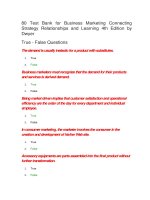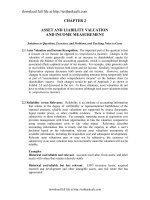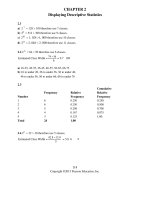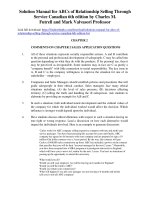Solution manual for business data communications infrastructure networking and security 7th edition by stallings
Bạn đang xem bản rút gọn của tài liệu. Xem và tải ngay bản đầy đủ của tài liệu tại đây (61.74 KB, 3 trang )
CHAPTER 1 INTRODUCTION
ANSWERS TO QUESTIONS
1.1
(1) Networks make it easier to manage geographically dispersed
operating locations. (2) They also help organizations deliver
information to workers in a timely manner, including anytimeanywhere on a mobile device if necessary. (3) Networks improve
communication and information management within and between
business organizations. Good networks bring business partners closer
together in ways that improve efficiency, customer service, agility, and
innovation.
1.2
Communication traffic, both local (within a building or business
campus) and long distance, has been growing at a high and steady
rate for decades. Network traffic is no longer limited to voice and data
and increasingly includes image and video. Increasing business
emphasis on web services, remote access, online transactions, and
social networking means that this trend is likely to continue.
As businesses rely more and more on information technology,
the range of services that business users desire to consume is
expanding. For example, mobile broadband traffic growth is exploding
as is the amount of data being pushed over mobile networks by
business users’ smart phones and tablets. In addition, over time,
mobile users are increasingly demanding high quality services to
support their high resolution camera phones, favorite video streams
and high-end audio.
Four technology trends are particularly notable:
(1) The trend toward faster and cheaper, both in computing and
communications, continues.
(2) Today’s networks are more "intelligent" than ever.
(3) The Internet, the Web, and associated applications have
emerged as dominant features for both business and personal
network landscapes.
(4) While there has been a trend toward mobility for decades, the
mobility explosion has occurred and has liberated workers from
the confines of the physical enterprise.
1.3
Convergence refers to the merger of previously distinct telephony and
information technologies and markets. The benefits include:
(1) cost savings, through reduction in network management costs
and through better use of existing resources;
-5-
Full file at />
(2)
(3)
effectiveness, allowing companies to employ a more mobile
workforce;
transformation: converged IP networks can easily adapt to new
functions and features as they become available through
technological advancements without having to install new
infrastructure.
1.4
A concept related to that of convergence is unified communications
(UC). Whereas convergence focuses on the merger of fundamental
voice, video, and data communications facilities and the resulting
ability to support multimedia applications, UC focuses on the user
perspective to the broad spectrum of business applications. Three
major categories of benefits are typically realized by organizations that
use UC:
(1) personal productivity gains, through effective use of presence
information;
(2) workgroup performance gains, through real-time collaboration;
(3) enterprise-level process improvements: IP convergence enables
UC to be integrated with enterprise-wide and departmental-level
applications, business processes, and workflows.
1.5
Voice communications, data communications, image communications,
and video communications are all found on networks.
1.6
Optical fiber transmission has become more common because of its
high capacity and security characteristics.
1.7
Wireless transmission is becoming more common in business for much
the same reason as it is for consumers: convenience and mobility.
1.8
Distributed data processing has become more common because of the
widespread use of PCs, laptops, and mobile computing devices, the
deployment of wireless LANs, and the push to support mobile workers.
1.9
Application software performs a specific function such as accounting
while interconnection software ensures that all computers and
terminals speak the same language and can be connected together.
1.10 There are several key distinctions between LANs and WANs.
(1) The geographic scope of the LAN is small, typically a single
building or a cluster of buildings.
(2) It is usually the case that switches and communication
equipment used to implement the LAN are owned by the same
organization that owns the LAN-attached computing devices. For
WANs, this is less often the case, with all or at least a significant
-6-
Full file at />
(3)
fraction of the WAN circuits and switching nodes are not owned
by the business.
The internal data rates of LANs are typically much greater than
those of WANs. MANs are closer to LANs than WANs in terms of
these distinctions.
ANSWERS TO PROBLEMS
1.1
Answers will vary. The grading rubric for the paper should ensure
presence of acceptably accurate and complete definitions for each type
of cloud services. The rubric should also include two or more examples
of major providers for each cloud services category (e.g. for SaaS:
SalesForce.com, NetSuite.com; for IaaS: Amazon EC2, OpSource,
Rackspace; for PaaS: Amazon EC2, Google Apps, SAP).
1.2
Answers will vary. The grading rubric should ensure presence of
acceptably accurate and complete URLs for at least three YouTube
videos that focus on Unified Communications. It should also include
sufficiently complete and compelling justification for the video selected
as being best. It may include presence of rationale for why the other
videos are not deemed to be the best.
1.3
Answers will vary. The grading rubric for the paper should ensure
presence of acceptably complete descriptions of the business benefits
derived by three or more organizations that have implemented UC.
The rubric may include the presence of examples of benefits realized
at personal, workgroup, and enterprise-wide levels.
1.4
Answers will vary. The grading rubric for the paper should ensure
presence of acceptably complete descriptions of the business benefits
derived by three or more organizations that have implemented IPTV
and the business rationale underlying its implementation.
1.5
Answers will vary. The grading rubric for the paper should ensure
presence of acceptably complete descriptions of Metro Ethernet and
two or more MAN alternatives. The rubric may include the presence of
both wireless and wired MAN alternatives.
1.6
Answers will vary. The rubric should include presence of two or more
Web cam images including one for the student in the screenshots. It
should also include at least one chat session window. It may require
evidence of Skype or another well-known real time multimedia
communication environment that combines voice, video, and chat.
-7-
Full file at />









